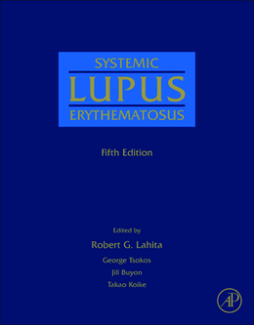
BOOK
Systemic Lupus Erythematosus
Robert G. Lahita | George Tsokos | Jill P. Buyon | Takao Koike
(2010)
Additional Information
Book Details
Abstract
Systemic lupus erythematosus (S.L.E.), commonly called lupus, is a chronic autoimmune disorder that can affect virtually any organ of the body. In lupus, the body's immune system, which normally functions to protect against foreign invaders, becomes hyperactive, forming antibodies that attack normal tissues and organs, including the skin, joints, kidneys, brain, heart, lungs, and blood. Lupus is characterized by periods of illness, called flares, and periods of wellness, or remission.
Because its symptoms come and go and mimic those of other diseases, lupus is difficult to diagnose. There is no single laboratory test that can definitively prove that a person has the complex illness.
To date, lupus has no known cause or cure. Early detection and treatment is the key to a better health outcome and can usually lessen the progression and severity of the disease. Anti-inflammatory drugs, anti-malarials, and steroids (such as cortisone and others) are often used to treat lupus. Cytotoxic chemotherapies, similar to those used in the treatment of cancer, are also used to suppress the immune system in lupus patients.
A new edition of this established and well regarded reference which combines basic science with clinical science to provide a translational medicine model. Systemic Lupus Erythematosus is a useful reference for specialists in the diagnosis and management of patients with SLE, a tool for measurement of clinical activity for pharmaceutical development and basic research of the disease and a reference work for hospital libraries.
- Highly illustrated and in full color throughout
- Basic science section expanded to allow the reader to focus on the newest techniques in molecular medicine and its effects on disease expression and treatment
- Clinical aspects and new drugs will be covered in great detail providing a useful reference to both experienced clinicians and physicians with an interest in lupus in their clinical practice
Published Review of 4th Edition
The editor's purpose ?is to provide the reader with the latest information about SLE, its science, presentation, and treatment.? This edition of Systemic Lupus Erythematosus continues to be an up-to-date, comprehensive, and well-referenced resource for both the basic science and clinical medicine aspects of this complex disease. The book takes us on a journey starting with the disease pathogenesis, continuing with animal models of lupus, various autoantibodies and antigens, the clinical approach to diagnosis and the affected organs and tissues, and ending with current therapies. It will be an excellent reference book for students of immunology/rheumatology and for experienced research scientists and clinicians. Reflecting the emerging information in this dynamic field, the volume includes new chapters on fibromyalgia and osteoporosis in association with SLE, and enhanced chapters on the molecular aspects of the cellular immunology of SLE, the neuropsychiatric aspects of SLE, and the various aspects of antiphospholipid syndrome. The addition of a searchable CD-ROM makes it easier to identify the updated information and to download the images for educational purposes. The chapters are written by experts in their respective fields, and each chapter independently represents a piece of the lupus puzzle. As Dr Lahita states in the introduction, ?Reading the chapters in this book will not solve the mystery, but it will give you the impression that we are close to understanding the illness?.
BP Tsao, Rheumatology, 2004
Published Review of 3rd Edition
"This book successfully links basic science with clinical medicine, providing a framework within which to understand this complex disease. As Lahita states in the introduction, 'The history of discovery is now in the log phase of growth.' The third edition of Systemic Lupus Erythematosus conveys the excitement and the breadth of this dynamic field. This volume will be an excellent resource for basic and clinical scientists, as well as for the students of imunology and rheumatology. The chapters are well-referenced and can be read independently- as befits a reference book."
-Jane E. Salmon, Weill Medical College, Cornell University, New York, USA (March 2000)
